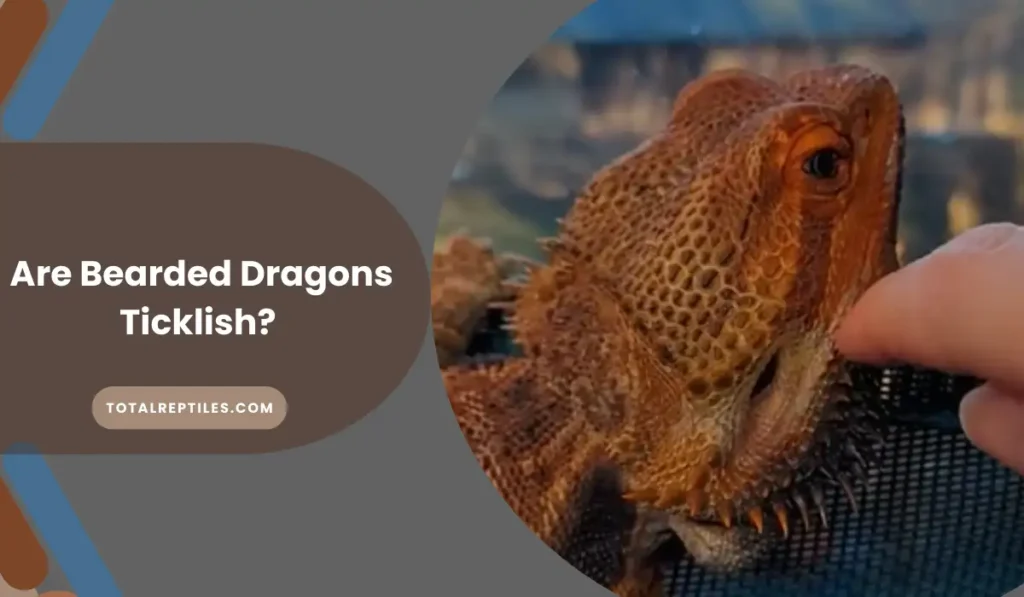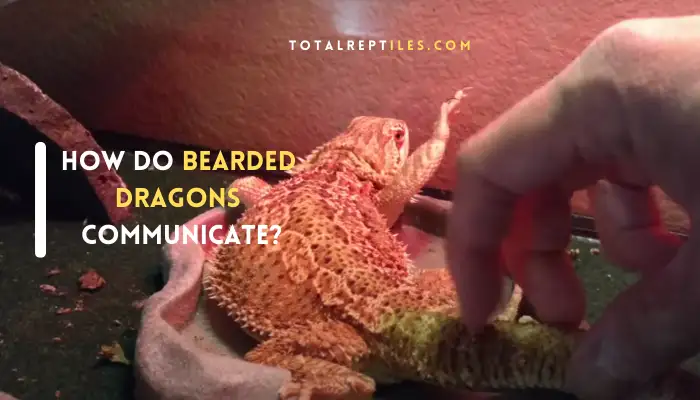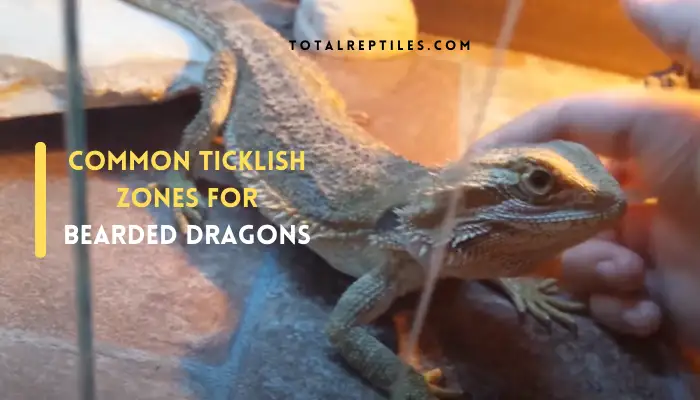Have you ever wondered if your beloved bearded dragon is ticklish? As you pet and handle these intriguing reptiles, do they secretly enjoy being tickled just as much as other animals? It’s a curious question many bearded dragon owners ponder. In this article, we’ll examine the research and evidence surrounding bearded dragon ticklishness.
To understand if bearded dragons could feel tickled, we first need to examine some background on their biology and behaviour. As reptiles, bearded dragons possess unique characteristics that aid their sensory perception and communication.

How Do Bearded Dragons Communicate?
Although not the most vocal reptiles, bearded dragons have evolved exciting ways to communicate and interact with members of their species and human owners. Their main communication methods include:
- Body language – head bobbing, arm waving, puffing out throat, postures signalling aggression or submission
- Colour changes – signalling mood, social status, health condition
- Behaviours – glass surfing when stressed/bored, brumation during cooler months
In terms of social abilities, studies show bearded dragons:
- Can recognize familiar individuals and form social bonds
- Enjoy gentle handling from accustomed human owners
- May engage in “playful” behaviours like exploring new objects or environments
Our scaly friends can not speak or laugh like humans but have enough sensory perception and intelligence to feel tickling. But what does the research indicate specifically regarding bearded dragon ticklishness? Let’s analyze some leading theories.
Key Theories & Research on Bearded Dragon Ticklish Spots
Before surveying the evidence on bearded dragons specifically, it helps to understand the concept of ticklishness more broadly across animals.

What is Ticklishness Exactly?
Ticklishness is the involuntary but stimulating response to mild touch on sensitive skin and nerves. It provokes squirming, twitching, giggle-like vocalizations, or cringing-type reactions.
In humans, tickling most often evokes uncontrolled laughter and snorts. It appears linked to building social bonds, emotional communication, and harmless play aggression.
Some animal species likewise feel tickly when handled, suggesting that may be evolutionary. Scientists theorize it could involve:
- Sensitive nerve endings close to the skin surface
- A reflex physical response when those areas receive stimuli
- Enhancing social cohesion through reciprocal touch
So, could reptiles like bearded dragons potentially have areas that elicit a ticklish reaction? Reports from bearded dragon owners indicate they just might.
Evidence That Bearded Dragons May Feel Ticklish
Over the years, many bearded dragon fans have noticed their pets displaying unusual responses when handled:
- Squirming, shaking legs, or cringing when bellies/hindlegs are touched lightly
- Closing eyes, relaxing muscles, and purring during chin scratches
- Lifting a foot off the ground if it’s stroked, as if tickled
- Playfully interacting longer with owners who pet them
Furthermore, various reptiles demonstrate activity in the same areas of the brain that govern pleasure and reward for mammals. Their reactions to physical touch also suggest a capacity to feel complex sensations and emotions.
With this supporting evidence, it becomes plausible that bearded dragons may have sensitive areas that induce tickling. But despite the potential, individual dragons can react differently based on their distinct traits.
Why Reactions Vary Between Bearded Dragons?
No two bearded dragons – even within the same clutch – have the same personality and tendencies. Individual preferences, tolerances, and perceptions of human treatment will vary.
These individual quirks relate to factors like:
- Breed and genetic lineage
- Early life experiences with touch
- Basal stress and activity levels
- Bonding level with the owner
- Preferred interaction type
For these reasons, one bearded dragon may relish belly rubs while another could feel seriously annoyed by them. The same goes for tactile stimulation almost anywhere on their bodies. Reactions genuinely run the gamut between individuals.
So, where exactly are most bearded dragons sensitive to tickling touches within this framework?
Common Ticklish Zones For Bearded Dragons
Bearded dragon fans and herpetologists report that some regions are ticklish when handled carefully.

The Belly
The belly/underarm region tends to be quite sensitive to bearded dragons. When lightly stroked there, many lift their legs reflexively or scrunch up their stomach as if tickled. Since the belly has sparse scales and thinner skin, it likely contains more concentrated nerves able to sense light physical stimulation.
Gently running fingers over a bearded dragon’s belly may cause them to:
- Squirm side to side
- Scratch frantically at the touched spot
- Wave legs as if swimming
Take care not to press too hard on the abdomen, as internal organs lie close under the skin. And steer clear of touching near the cloacal vent area to avoid disturbing your scaly buddy!
The Chin & Cheeks
The chin and cheeks are also ticklish, maybe due to finer facial scales and more nerve endings. Gentle strokes under the mouth often elicit happy reactions in bearded dragons:
- Closing eyes while lifting the head
- Purring or bruxing teeth contentedly
- Sitting statue-still to savor the sensation
- Increased bonding behaviour later on
Petting a bearded dragon under its chin or jawline relaxes and calms them. This suggests stimulating these facial nerves releases endorphins related to pleasure and comfort.
The Feet & Tail
Oddly enough, some bearded dragons also demonstrate ticklish responses when their feet or tails get delicately handled. Reactions can include:
- Limb jolts as if receiving an electric shock
- Agitated tail whipping side to side
- Speedy scurrying away from the stimulation
These types of intense responses imply the feet and tail are extra sensitive. So gently caress them with your fingertips.
Beardie owners may help their pets have fun tickling by learning these main ticklish spots and basic handling skills. But safety and respect should remain the top priorities during these interactions.
How To Safely Tickle Your Bearded Dragon?
While tickling may entertain some bearded dragons, their comfort and well-being must stay at the forefront. By no means should tickling ever cause distress or push a beardie’s boundaries. Here are some tips on the safest tickling methods.
Start With Brief Light Touches
When first gauging your bearded dragon’s ticklishness, use only faint brushes of contact:
- Begin with one fingertip for just 1-2 seconds
- Try belly, then chin, then feet/tail regions
- Keep sessions very short initially
See how your scaly companion responds without additional handling sensations overwhelming them.
Slowly Increase Pressure If the Positive
If your bearded dragon seems to appreciate the initial feathery tickles, try gradually intensifying stimulation:
- Move to 2-3 fingertips, contact for 4-5 seconds
- Apply slightly firmer but still gentle pressure
- Switch between belly, chin, and back regions
But refrain from full tickle attacks at first in order to not scare an otherwise ticklish beardie.
Watch Closely For Negative Reactions
Even if your bearded dragon enjoyed tickling before, remain vigilant for signs of discomfort:
- Hissing/gaping mouth
- Arm waving
- Attempts to escape
- Beard changes colour
Immediately cease all tickling when seeing these stressed behaviours. Your pet’s comfort takes top priority over any bonding or enjoyment during handling.
Don’t Push Limits or Force Interactions
Never try to purposely annoy or overwhelm your beardie just to get amusing reactions. And absolutely avoid tickling areas your specific dragon doesn’t like. This ruins trust and can really stress them internally.
Set tickling boundaries aligned with your individual pet’s preferences. And place their wellness at the center of all attempted tickle-play sessions.
FAQ
Can you tickle a bearded dragon’s belly?
Yes, many bearded dragons appear sensitive or ticklish on their bellies when touched gently. Use only 1-2 fingertips for a few seconds initially. Watch closely for reactions like leg scrunches or squirming, which often indicate feeling tickled.
Where are bearded dragons most ticklish?
Prime ticklish spots include the belly, underarms, chin, cheeks, lower back, base of tail, and feet. Try stimulating different regions lightly to gauge your bearded dragon’s unique reactions. But limit tickles to areas they seem to appreciate.
Do bearded dragons like being tickled?
Arm-waving, hissing, biting, or fleeing away indicate that some bearded dragons dislike tickling while others enjoy it. Be aware of your pet’s reactions and stop if they seem uncomfortable. Their body language is key when determining if they like tickles or not.
Can too much tickling upset a bearded dragon?
Yes, overdoing the tickling can stress out your bearded dragon. Excessive, intense, or unwanted touching risks annoying beardies to the point of aggression. Honour their personal preferences, and keep tickle sessions infrequent and mild.
Conclusion
While more scientific research is still needed, the evidence indicates that some bearded dragons likely enjoy gentle tickling. The outward signs suggest it provides pleasing stimulation for specific individuals. Some bearded dragons dislike being tickled, as shown by unpleasant reactions. And even for generally ticklish beardies, overdoing it can quickly trigger aggression.
In the end, ticklishness remains a highly individual trait depending on the bearded dragon’s unique personality. Pet owners must carefully assess and adapt all tactile interactions to align with their specific pet’s comfort levels. Safety and respect for personal boundaries should take priority over assumptions of the reptile enjoying any handled stimulation, tickling or otherwise.
As you bond more over time, your bearded dragon will reveal just how ticklish they may be through their distinctive reactions. But always let their behaviours guide the experience to ensure their enrichment and care come first before your amusement.

